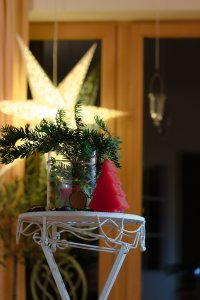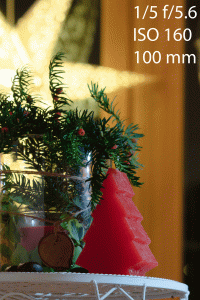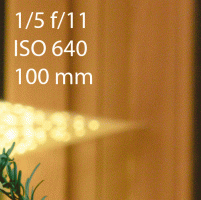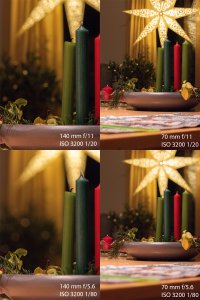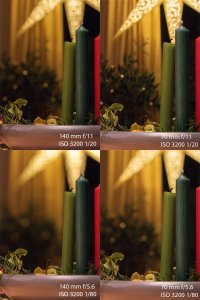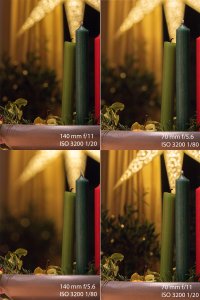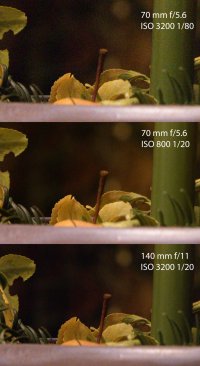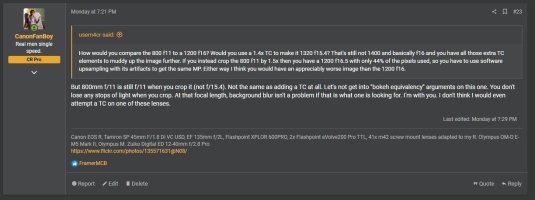Noise
Noise is that fuzzy stuff that shows up in my pictures when the lighting conditions are not ideal, right? So what is it and where does it come from?
Noise is just a variation in the pixel values that does not reflect the actual properties of the subject. So, it is pixels being brighter or darker than you expect them to be, given the object that they get their color from.
There are two main types of noise. One is the noise that is generated in your camera. The temperature the sensor is at during the exposure is responsible for part of that noise, called dark current noise. The lower the temperature, the less noise is added through this. Heat is just a form of energy and some of that energy can take the form of charge inside a pixel. Another source of noise are the analog electronics in the camera themselves. They are not perfect, and so they create little errors in the data before it is converted to a digital format that can be made much more resiliant against corruption caused by our messy physical world.
Let's have a look at some of this noise. I took a series of images with the lens cap on and the viewfinder covered. I used both my 80D and a friend's 90D for this, so we can have a look at the differences between an older and newer sensor of the same size. Lens, aperture and shutter speed are all the same between these shots: Sigma 35mm 1.4 Art, f/2.8 (doesn't really matter with the lens cap on), 1/50s. Same whitebalance for each. Shots taken over very small amount of time, indoors. So the temperature is very similar. All the noise in these images is caused by this thermal energy or the camera electronics. The upper two rows show the images unedited - Luminance and color noise reduction in Lightroom turned off, no sharpening, no profile corrections. This will be true for all my images. The lower row is normalized in brightness, so that we are comparing apples to apples. The number of stops the exposure was pushed in Lightroom is shown as (stops) at the top of each column.
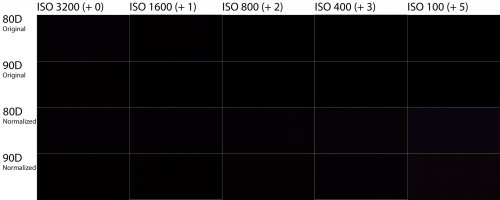
Without any noise, these images would just be pure black, as there is absolutely no light. Notice that isn't the case though and especially with the lower ISO shots that had the exposure raised, the dark current and read noise are really visible.
But wait, how is it apples to apples comparing images where the exposure was raised by different amounts in post?
Well, the only difference in these shots is the selected ISO. And what does ISO influence? The brightness of the image. So if we want to compare images at the same brightness, the ones taken with a lower ISO have to be brightened in post. Doing that does not add any noise, it is a purely digital process. Whatever noise we see is already in the image file, you just couldn't see it previously because it was so dark!
These are the aspects that camera manufacturers have control over and have spent generations of camera bodies to improve. Notice also how little of it there is in the 90D images. They have improved so much now, that for many situations, these types of noise actually aren't the limiting factor for low light performance anymore.
That would be the second kind of noise: a property of light itself, called shot noise. To me, this was initally very unintuitive. But yes, light is actually noisy. Even a perfect sensor, created by the all powerful religious being of your chosing, would not be able to create a noise free image unless said being also altered the properties of light. An analogy you'll often find on the internet is comparing the electrons that are responsible for your image to raindrops, and the pixels to buckets.
As the rain is coming in the form of discrete drops, not all pixel buckets will have the same amount of water in them at all times. But as the amount of water (light) increases, these little differences become less and less apparent. How these little difference compare to the total amount of water (light) is what the signal to noise ratio expresses. I won't go into the details of how it is calculated, since there's already such a great source for this out there:
Jon Rista on SNR
Jon Rista goes into great detail on the mathematics behind it in the context of the most low light photography there is: astro. I believe he also is a former member of this forum (
jrista) who posted absolutely magnificient images.
What this means though, is that if we ignore the noise generated in camera, what ultimately determines how visible noise is in the image depends on how much light this image contains. What determines how much light goes into an image? Three things: The amount of light per area and time that falls onto the sensor, the area of this sensor and the time over which light is gathered.
But wait, a small pixel has a lesser area than a large one, so it gathers less light. That has to matter, right?
Well, yes. If you look at individual pixels. But when looking at an area of multiple pixels, like an image, all the pixels in it are averaged by the software that produces the image you are looking at on your screen. Or in the case of a print, your eyes handle that.
And ISO? I see a lot of noise in my images when I use high ISO values!
Yes, that is to be expected - you usually will raise the ISO when the amount of light you gather is not producing the desired brightness and you can't use a larger aperture or longer shutter speed, right? So, in other words, whenever you use a larger ISO, you are capturing a smaller amount of light than when using a small ISO. But it is not the ISO itself that is introducing the noise into your images - The small amount of light is responsible for that!
Alright, so are you saying ISO doesn't matter and I get the same image quality as long as I keep the f/number and shutter speed the same?
Basically, yes. So let's do just that and have a look. Same thing as before, Sigma 35mm 1.4 Art, f/2.8, 1/50s, no noise reduction, sharpening or profile corrections in Lightroom. This time, the lens cap's off and we're looking at a small crop (the same relative crop for each) showing a dimly lit wall. The image is out of focus so that the texture of the wall doesn't show up. Upper two rows are unedited, lower to pushed by the amount stated in the brackets at the top.
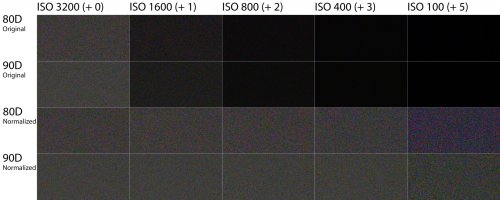
Notice that the normalized 90D images look very similar, regardless of ISO! And that for the 80D, pushing digitally in post rather then selecting a higher ISO to achieve the desired brightness actually results in a much more noisy image! In this crop, it is not visible, but there's also a lot of banding in the raised 80D ISO 100 shot when viewed at full size. Yikes!
So in other words, if you don't want your image to look noisy: Gather as much light as possible using a long shutter speed and wide aperture. If you can't achieve your desired brightness that way, crank up the ISO in camera as far as necessary. You will get worse results if your camera isn't one of the very recent models and you have to brighten in post. Also be aware that higher ISOs have lower dynamic range though. So there absolutely is a time and place for shooting an image that looks to dark in camera and boosting in post, if you want to preserve highlights. Especially with how little read noise there is in these modern sensors.
Okay, but what about the sensor size then? When my image comes from a smaller physical area, it has less total light in it. Does cropping or shooting with a smaller sensor really give the same effect as gathering less light by using a shorter shutter speed?
Let's try just that. Same thing as before, no NR, sharpening, same aperture and lens, looking at a (almost) uniformly lit, out of focus wall. Only the 80D this time, as I had to give back the 90D by the time I took this test. All shots have the same brightness, of course. So, to make the noise more apparent, I pushed them all by 4 stops in the lower rows. This is as far as I can push the 80D before banding shows up. The bottom row shows a section of the middle row that is cropped to compensate for the difference in total light. So, no crop at all on the left most image, cropped to half the area in the second one from the left, 1/4 the area in the third one, 1/8 the area in the forth one, and so on. So in the bottom row, all images are made up of the same amount of light.

Things to note here? First, the color goes off the rails as the light drops. Not sure what's causing that. But apart from that, noise in the bottom section looks really consistent between all of these. Which is what I would expect based on the three main factors I named earlier. After all, as we go from left to right, the exposure times gets cut in half, but the area doubles, resulting in the same amount of light. And so, why would the noise be any different?
 What's up with all this talk about equivalency that seemingly derails every thread around here?
What's up with all this talk about equivalency that seemingly derails every thread around here?




